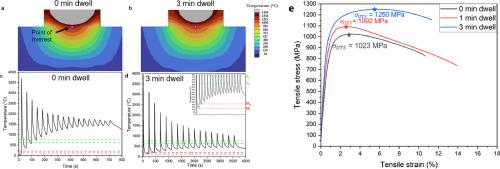当前位置:
X-MOL 学术
›
J. Mater. Sci. Technol.
›
论文详情
Our official English website, www.x-mol.net, welcomes your feedback! (Note: you will need to create a separate account there.)
Martensitic transformation induced strength-ductility synergy in additively manufactured maraging 250 steel by thermal history engineering
Journal of Materials Science & Technology ( IF 11.2 ) Pub Date : 2024-06-22 , DOI: 10.1016/j.jmst.2024.05.062 Shahryar Mooraj , Shuai Feng , Matthew Luebbe , Matthew Register , Jian Liu , Tianyi Li , Baris Yavas , David P. Schmidt , Matthew W. Priddy , Michael B. Nicholas , Victor K. Champagne , Mark Aindow , Haiming Wen , Wen Chen
Journal of Materials Science & Technology ( IF 11.2 ) Pub Date : 2024-06-22 , DOI: 10.1016/j.jmst.2024.05.062 Shahryar Mooraj , Shuai Feng , Matthew Luebbe , Matthew Register , Jian Liu , Tianyi Li , Baris Yavas , David P. Schmidt , Matthew W. Priddy , Michael B. Nicholas , Victor K. Champagne , Mark Aindow , Haiming Wen , Wen Chen

|
Maraging steels are known for their exceptional strength but suffer from limited work hardening and ductility. Here, we report an intermittent printing strategy to tailor the microstructure and mechanical properties of maraging 250 steel via tuning the thermal history during wire-arc directed energy deposition. By introducing a dwell time between adjacent layers, the maraging 250 steel is cooled below the martensite start temperature, triggering thermally-driven martensitic transformation during the printing process. Thermal cycling during subsequent layer deposition results in the formation of reverted austenite which shows a refined microstructure and induces elemental segregation between martensite and reverted austenite. The Ni enrichment in the austenite promotes stabilization of the reverted austenite upon cooling to room temperature. The reverted austenite is metastable during deformation, leading to strain-induced martensitic transformation under loading. Specifically, a 3 min interlayer dwell time produces a maraging 250 steel with approximately 8% reverted austenite, resulting in improved work hardening via martensitic transformation induced plasticity during deformation. Meanwhile, the higher cooling rate and refined prior austenite grains lead to substantially refined martensitic grains (by approximately fivefold) together with an increased dislocation density. With 3 min interlayer dwell time, the yield strength of the printed maraging 250 steel increases from 836 MPa to 990 MPa, and the uniform elongation is doubled from 3.2% to 6.5%. This intermittent deposition strategy demonstrates the potential to tune the microstructure of maraging steels for achieving strength-ductility synergy by engineering the thermal history during additive manufacturing.
中文翻译:

通过热历史工程增材制造马氏体时效 250 钢中马氏体相变诱导的强度-延展性协同作用
马氏体时效钢以其卓越的强度而闻名,但加工硬化和延展性有限。在这里,我们报告了一种间歇打印策略,通过调整线弧定向能量沉积过程中的热历史来定制马氏体时效 250 钢的微观结构和机械性能。通过在相邻层之间引入停留时间,马氏体时效 250 钢被冷却到马氏体起始温度以下,从而在打印过程中触发热驱动的马氏体转变。随后层沉积期间的热循环导致回复奥氏体的形成,其显示出细化的微观结构并引起马氏体和回复奥氏体之间的元素偏析。奥氏体中镍的富集促进了冷却至室温后回复奥氏体的稳定。回复奥氏体在变形过程中是亚稳态的,导致在载荷作用下发生应变诱发的马氏体转变。具体来说,3 分钟的层间停留时间可产生约 8% 回复奥氏体的马氏体时效 250 钢,从而通过变形过程中马氏体相变诱导的塑性改善加工硬化。同时,较高的冷却速率和细化的原奥氏体晶粒导致马氏体晶粒显着细化(大约五倍),同时位错密度增加。层间停留时间为3 min时,打印的马氏体时效250钢的屈服强度从836 MPa增加到990 MPa,均匀伸长率从3.2%增加一倍到6.5%。这种间歇沉积策略展示了通过设计增材制造过程中的热历史来调整马氏体时效钢的微观结构以实现强度-延展性协同作用的潜力。
更新日期:2024-06-22
中文翻译:

通过热历史工程增材制造马氏体时效 250 钢中马氏体相变诱导的强度-延展性协同作用
马氏体时效钢以其卓越的强度而闻名,但加工硬化和延展性有限。在这里,我们报告了一种间歇打印策略,通过调整线弧定向能量沉积过程中的热历史来定制马氏体时效 250 钢的微观结构和机械性能。通过在相邻层之间引入停留时间,马氏体时效 250 钢被冷却到马氏体起始温度以下,从而在打印过程中触发热驱动的马氏体转变。随后层沉积期间的热循环导致回复奥氏体的形成,其显示出细化的微观结构并引起马氏体和回复奥氏体之间的元素偏析。奥氏体中镍的富集促进了冷却至室温后回复奥氏体的稳定。回复奥氏体在变形过程中是亚稳态的,导致在载荷作用下发生应变诱发的马氏体转变。具体来说,3 分钟的层间停留时间可产生约 8% 回复奥氏体的马氏体时效 250 钢,从而通过变形过程中马氏体相变诱导的塑性改善加工硬化。同时,较高的冷却速率和细化的原奥氏体晶粒导致马氏体晶粒显着细化(大约五倍),同时位错密度增加。层间停留时间为3 min时,打印的马氏体时效250钢的屈服强度从836 MPa增加到990 MPa,均匀伸长率从3.2%增加一倍到6.5%。这种间歇沉积策略展示了通过设计增材制造过程中的热历史来调整马氏体时效钢的微观结构以实现强度-延展性协同作用的潜力。











































 京公网安备 11010802027423号
京公网安备 11010802027423号